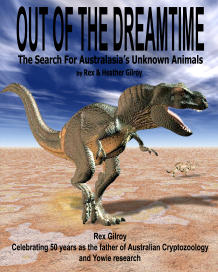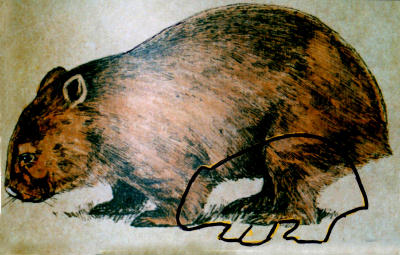
Sketch reconstruction of the Giant Wombat, Phascolonus gigas, in comparison to a modern wombat shown in outline.
Read Excerpts From
Out Of The Dreamtime -
The Search for Australasia’s Unknown Animals
by Rex & Heather Gilroy
Copyright
© Rex Gilroy 2006
No part of this publication including all photographs and illustrations may be reproduced or transmitted in any form or by any means, electronic or mechanical, including photocopying, recording or any information storage and retrieval system now known or to be invented, without permission in writing from the publisher, except by a reviewer who wishes to quote brief passages in connection with a review, written for inclusion in a magazine, newspaper or broadcast.
Dedication
This book is affectionately dedicated to my loyal, supportive and dedicated wife, and Number One researcher and fieldworker, Heather. This book is also affectionately dedicated to my late father W.F. [Bill] Gilroy [1904-1996], whose tales of his native Scotland and the Loch Ness Monster, led me, from about the age of five [!] to my lifelong research of the natural sciences and the fields of Cryptozoology and relict hominology, which has resulted in this book.
PART THREE
LIONS AND TIGERS OF THE
AUSTRALIAN BUSHLAND
__________
CHAPTER TEN
Living Mega-Marsupials?
The Dreamtime legendary tales of Australia’s Aboriginal people are rich in traditions of ‘bunyips’, or rather, creatures of a past age, all now long-extinct. Or are they?
Conservative, university-based scientists may scoff at these traditions, yet when we consider the number of ‘mythical’ bunyips such as the giant monitor lizard, giant snakes, giant flightless birds, giant kangaroos, giant wombat and the Diprotodon [to name but some] that have turned up in the fossil record, we can only conclude that our Aboriginal people of past ages were keen observers, whose information has been passed down through countless generations to the present.
In other words, our modern-day Aboriginal people are the bearers of a valuable Cryptozoological record! Therefore, whenever they speak of any one of these ‘bunyips’ of the past as surviving, hidden from modern human interference somewhere ‘out there’ in the vast Australian bush, I believe we should accept such claims as statements of fact. This chapter concerns itself with possible surviving species of the marsupial megafauna, living fossils from the dawn of time that seem to beckon us back to a past age - the age of giants.
For sheer bulk, the largest marsupial that ever lived was Diprotodon optatum, which supposedly became extinct by several thousand years ago in the wake of the close of the Pleistocene period. This great lumbering, wombat-like animal was an herbivore which the Aborigines claimed, inhabited the forests, swamps and billabongs. These monstrous marsupials have come to be most identified with the fabled Bunyip.
Their fossil remains have turned up throughout Australia and belong to a whole family of four-footed, browsing marsupial herbivores, the Diprotodontidae, which flourished during late Tertiary times, but which declined in diversity during the Pleistocene when Diprotodon optatum lived. Their gap was filled by the rise of the kangaroos. Diprotodon optatum was the first fossil mammal named from Australia. The scientific [Latin] name given this giant means “southern animal with two forward-projecting teeth”. When it was first recognised in 1838, only a few teeth and a fragment of jaw were available for study, and it was not until 1893 that feet bones were finally discovered.
Today we know a great deal more about these lumbering giants, thanks to an Aboriginal stockman, Charlie Pierce, who in 1893 stumbled upon skeletal remains of these creatures at Lake Callabonna in South Australia.
Since then more than a hundred more or less complete skeletons of the Diprotodon have been recovered from this ancient salt lake, as well as fossil remains of many other extinct giants of Late Pleistocene age; the giant flightless bird, Genyornis; Sthenurus, the giant kangaroo; and Thylacoleo, the Marsupial Lion, to list but some.
Diprotodon optatum was indeed a large animal, nearly 3m in length, standing 2m tall at the shoulder. The skull alone was as much as 90cm in length.Scientific opinion varies on the actual extinction time zone for the Diprotodon; some argue between 15,000 and 25,000 years BP, others believe the species [and no doubt certain others] lingered on into the last several thousand years. Aboriginal traditions of Diprotodon and other megafauna date back much farther than these estimates. Yet Anthropologists concerned with the study of oral folklores worldwide, have pointed out that, in many cases an oral tradition could not survive more than three, perhaps five centuries without undergoing distortion and radical transformation.
Therefore, taking these university-trained authorities at their word, dare I suggest that Aboriginal people in one part of Australia or another dwelt alongside living Diprotodons within the last few hundred years? If the above be true, the same might also be said for certain other megafauna, such as more than one giant flightless bird, kangaroo species, and the ‘extinct’ giant monitor lizard – about which more will be revealed later on in this book!
Aboriginal traditions of the Diprotodon include names over a wide area of the continent. Tribespeople living throughout Central Australia knew the Diprotodon as Kadimakara, while in South Australia these animals were known as Gyedarra. Browsing animals of Diprotodon appearance are also to be found in the folklores of primitive New Guinea tribespeople, which is interesting, considering that diprotodontoid fossils of Pleistocene age have lately been coming to light from sediments in the Dani Valley, Irian Jaya.
Melanesian folklore of these Diprotodon-like animals are also know in Papua New Guinea, where early European explorers and settlers in the 19th century spoke of having either seen or found the freshly-made footprints of these mystery giants.
Captain John Moresby, R.N. who in 1873 surveyed the north-east coast in H.M.S. Basilisk, reported quite mater-of-fact, that the tracks of a “rhinoceros” had been discovered by a landing party which had been cutting wood in Collingwood Bay. He related that one of the Basilisk’s lieutenants had “observed the droppings of some large grass-eating animal in a spot where the bushes had been heavily trampled and broken”.
As rhinoceros’s have never existed in New Guinea, what other giant creature could it have been? Soon after Captain Moresby’s report, in 1875 the Reverend Samuel McFarlane returned from a short voyage up a south coast river, with tales of “buffalo” tracks having been found in the jungle thereabouts.
The “rhinoceros” and the “buffalo” were undoubtedly one-and-the-same animal. These reports led to speculation in 1878, by an explorer, Andrew Goldie, that the tracks might have been those of living Diprotodontids. He based his theory upon fossil remains of a Diprotodon which had recently been unearthed at a North Queensland site, and which were of more recent origin than those found elsewhere in Australia up to that time. The tracks displayed four toes it was said, and the belief grew that, somewhere in the interior of New Guinea these giant marsupials lived on in largely inaccessible regions.
Since those times there have been persistent rumours of living Diprotodons seen roaming the interior, by both tribespeople and Europeans alike. About the same time that Captain Moresby was reporting the ‘rhinoceros footprints’ found in Collingwood Bay, early settlers and gold prospectors who had begun penetrating the Australian interior, were reporting similar tracks, as well as actual sightings claims of rhinoceros-like animals, encountered in widely-scattered regions of eastern Australia, from Victoria to Queensland.
Other stories would come from settlers in South Australia and Western Australia, particularly from that state’s north, as well as Arnhem Land and the Gulf Country. One just does not know how to take such early settler’s tales sometimes; yet even if many were “tall tales’, there had to have been a factual basis for them to begin with. Many of these outback pioneers were illiterate, and certainly unfamiliar with fossil species such as the Diprotodon; they merely described the animals they saw in a matter-of-fact way, often passing on crude descriptions in which to explain themselves.
They would compare the physical similarities between the creature they were describing with another. Hence the seemingly ludicrous tales about “giant rabbits 10 feet in length” [ie about 3m] often employed by country folk when describing the large, hairy animals seen browsing around swamps or in the scrub. The “giant rabbit” descriptions and body proportions given by these people certainly resembles the Diprotodon.
There were settler’s tales over a vast area of the Australian outback during the 19th century, and which carried on into the early 20th century of giant-size kangaroos. Like the Diprotodon-type animal encounters of our pioneers, these tales could be heard in every mainland Australian state. We shall return to these giant kangaroo encounters anon.
*****
Old settlers of the Berrima district of the NSW southern highlands, at the beginning of the 20th century, could recall old stories from the mid-19th century, concerning encounters by settlers with enormous, Diprotodon-like animals in the bushland beyond the settled areas. There was a swampland that local Aborigines would not go near, for fear of the ‘bunyips’ that waded about in it.These ‘bunyips’ were by no means dangerous to humans, for they lived upon plant life, even so, the settlers seem to have left well enough alone, observing them from afar. Eventually the creatures appear to have left the area and moved on elsewhere Aborigines spoke of these same bunyips inhabiting the Burragorang Valley, and old settler’s tales of the Bathurst district west of the Blue Mountains, spoke of “huge, wombat-like bunyips” roaming the swamps and creeks in the hills beyond the town.
These same hairy bunyips were widely known to Aborigines in the Hunter Valley-New England district, and warned the early settlers of supposed dangers should anyone meet up with one or more of them. Thus they warned the settlers never to frequent certain lonely swamps and forested areas where these creatures lived. Similarly, in far northern NSW, Aborigines of the Lismore district kept well clear of a certain billabong where these animals were believed to live, although settlers who disobeyed the usual warnings failed to find any trace of these hairy giants
Yet, if as some researchers believe, these traditions were only 200 to 500 years old, then it is very likely that the former tribespeople of the Lismore district had lived contemporaneously with remnant groups of Diprotodons. If any Diprotodons survive today, they are certainly making themselves scarce. Yet there are tantalising tales emerging from the more remote regions of the most inaccessible forestlands of the rugged mountain ranges on the eastern side of Nundle State Forest; the remote swamplands of the Goulburn River National Park west of Denman, and the Wollongambie wilderness on the eastern fringe of Lithgow, itself part of the Blue Mountains National Park.
Main Book Index | Mysterious Australia Homepage | URU Homepage | Australian Yowie Research Centre
